Running Injuries
The most commonly seen running injuries are in the feet and knees. These overuse injuries can almost always be corrected with physical therapy. These injuries occur due to muscular imbalances and poor biomechanics that have developed due to repetitive incorrect motion. We are equipped to perform a running analysis to help treat and prevent running injuries. We are also on Youtube!
Patellofemoral Pain Syndrome
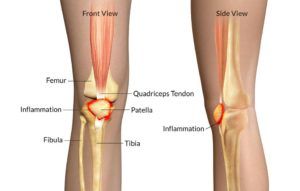
First, we will explore this pain syndrome. It typically presents as anterior knee pain, around the patella. There can be tenderness of the underside of the patella due to possible swelling in the knee joint. The knee can be swollen or full without actual swelling present. Potential cracking or popping can occur anywhere during the knee range of motion. Pain occurs with activity and is at its worst with going down stairs or hills.
Mechanism of Injury:
Tight quads cause excessive pressure on the femur. This pressure increases with running as a result of increased ground reaction force. The patella moves under the patellar tendon during quad contraction. Consequently, tightness in one location may lead to muscular imbalance. Then it glides excessively to one side due to imbalanced forces. Primarily, this muscular imbalance occurs in the VMO, hip abductors and hip external rotators. As a result, the excessive pressure and repetitive irritation of the bone occur. Ultimately, this leads to tissue breakdown.
Abnormal biomechanics that lead to PFPS:
- Excessive pronation
- Femoral anteversion
- Patella alta
- Increased Q angle
Physical Therapy Interventions:
- Initial decrease in running mileage
- Quad stretches
- Exercises to increase glute strength
Running Injuries: Patellar Tendonitis
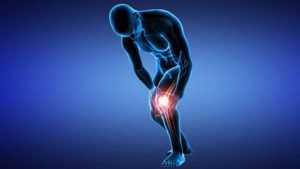
Traditionally, patellar tendon pain is felt below patella. If you feel pain at the beginning of an activity or directly after is indicative of acute tendinitis. As a result, pain may lead to termination of sport and interference with ADLs such as rising from a chair or climbing stairs.
Mechanism of Injury:
Next, repeated stress on the tendon results in microtears contributing to the tendinitis. Tightness in the quads are causes of stress to the tendon. Patellar tendinitis is also commonly paired with PFPS.
Physical Therapy Interventions:
- Decrease running mileage
- Exercises to strengthen glutes
- Progressive loading of quads
Achilles Tendonitis
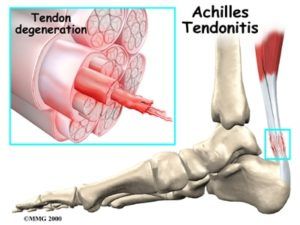
Achilles tendonitis pain presents in the heel or higher up on the Achilles tendon. The main complaint is pain and stiffness with walking and pain at it’s worst during initial movement. Many people complain of calf tightness when experiencing achilles pathology.
Mechanism of Injury
Irritation occurs when demand placed on the tendon outweighs the tendon’s capacity. Irritation results in microtraumas to the tendon. During normal walking, the tibia must roll over the foot. As a result, this lengthens the gastrocnemius complex. Achilles pain is also caused when the calf muscles are overused. Calf overuse is commonly due to decreased hip extensor strength and hip flexor range of motion.
Physical Therapy Interventions:
- Decrease running miles
- Slow increase in load to the Achilles tendon
- Increase glute strength
- Stretch hip flexors to increase hip extension ROM
Plantar Fasciitis
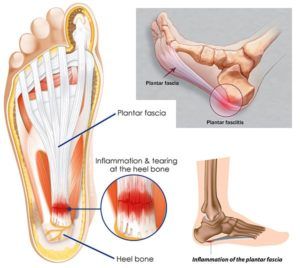
Primarily, plantar fasciitis presents as burning pain in the middle of the foot. Usually, pain is worse in the morning and after prolonged sitting or weight bearing. It is also increased during push off and toe walking.
Mechanism of Injury:
This pathology occurs due to stress on the fascia during the windlass mechanism. To further explain, the mechanism is essentially the shortening of the plantar fascia resulting from big toe extension. Stress on the fascia is due excess pronation resulting in decreased arch height. Flat feet further attribute as cause of plantar fasciitis in runners. Also, calf tightness can contribute to this condition. Plantar fasciitis also can be contributed to increased load or mileage of running.
Physical Therapy Interventions:
- Mobility exercises for ankle and plantar fascia
- Supportive footwear prescription
- Arch exercises
- Calf stretching
- Proximal hip strengthening
Shin Splints
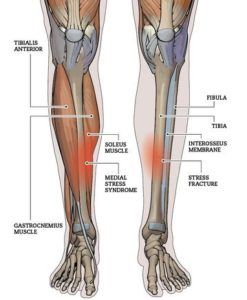
Medial tibial stress syndrome is another term used to name shin splints. Pain in the middle to bottom third of the inside of the shin is traditional to this pathology. Additionally, pain can be sharp to the touch or achey during or after exercise. If the condition progresses, pain might be present consistently.
Mechanism of Injury
Shin splints typically develop when muscular stress overloads the tibia. Muscles contributing to stress include; posterior tibialis, soleus and flexor digitorum longus muscle. Activites that contribute to shin splints include repetitive running/jumping, hypermobility of the hip, and too much weight bearing.
Physical Therapy Interventions:
- Arch exercises = preventing overpronation during stance
- Glute strengthening
- Footwear analysis
- Gentle stretching
